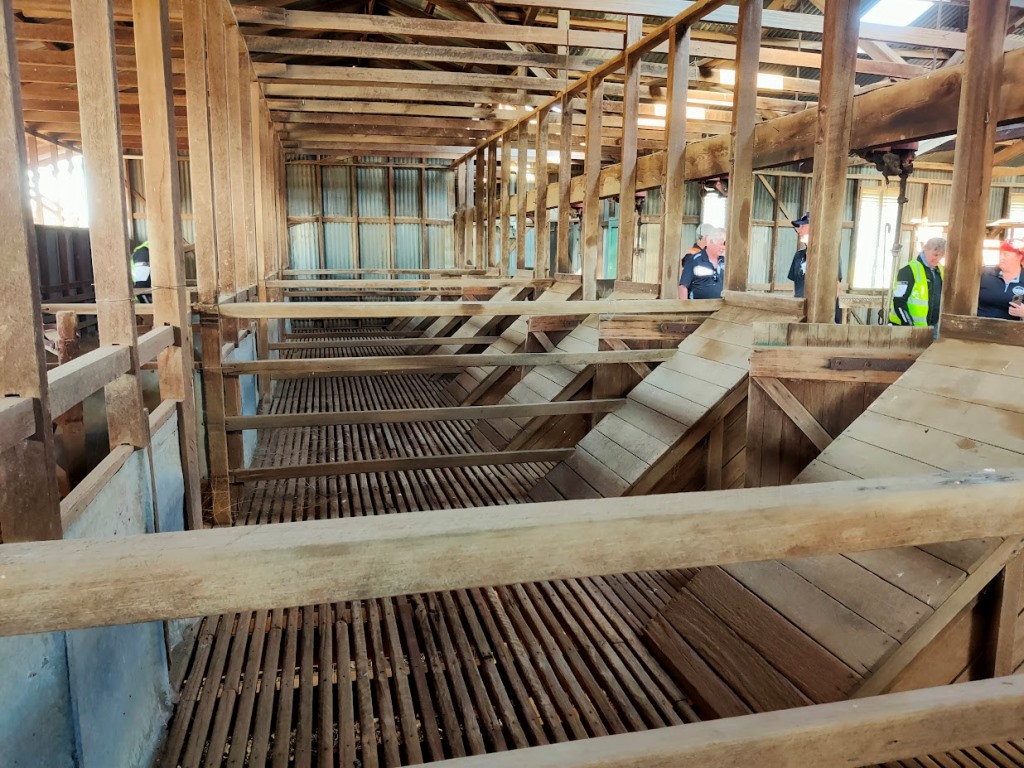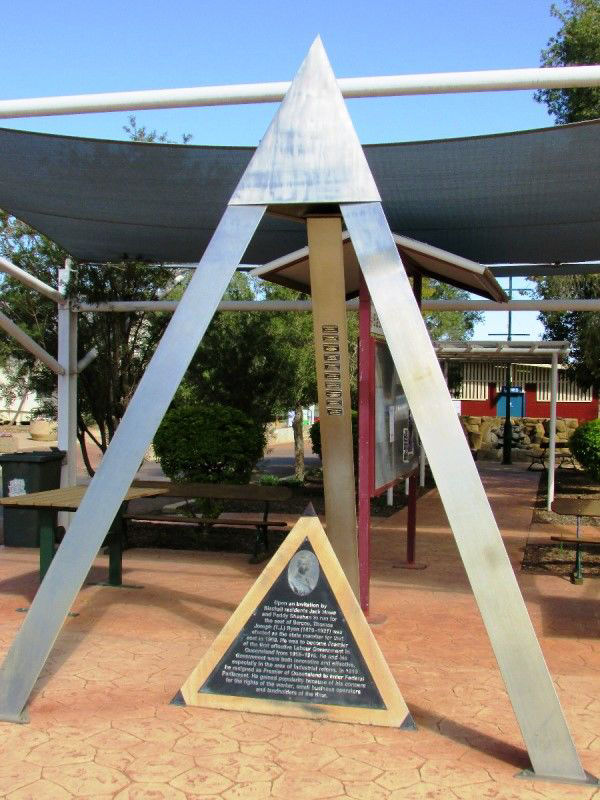|
|
|
|
|
A lot of the pics on these pages have been crunched to allow the pages to open quicker. You can get the HD versions by clicking each pic. |
|
|
|
Coming into Roma from the east you pass the Big Rig tourist attraction which is a display of the history, the trials, the wins and losses, associated with the discovery of oil and gas in the region. Unfortunately we didn’t have the time to do the tour.
Roma RSL Sub-Branch had obtained the nod for us to use the Roma Recreation Centre Hall for our accommodation requirements. The hall is owned by Roma Council and used by PCYC and another sporting bodies and as it contained toilet and shower facilities, it was perfect for our needs. It was also “just over the road” from the RSL club where arrangements had been made for our dinner that night.
|
|
Roma is known for its bottle trees, many of which have been planted throughout the town, the largest of which is a tourist attraction. This huge tree, which has a girth of 9.5 metres and which still grows at the rate of 1cm/year, was found on a local property in 1927, dug up and moved to its current position. It is over 100 years old.
We had to have a look!
Although the trees are thought to have a hollow trunk which contains water, that is not the case. Water is held in its fibrous trunk but not as free water.
|
|
Johnno, who is our bucket basher, is also a damn good cook. Armed with a bunch of money, he went shopping at Woolies, filled a few shopping bags then returned to the RSL and knocked up the best hamburgers I’ve tried for many a moon. After they were cooked on the barby, there was a pile so high I thought they would be eating them well into next week, to my surprise they all went in no time at all.
Johnno’s burgers rule!!
Dave Pedler had brought his trusty ukulele with him and intended to play a few tunes for the lovely Legacy ladies who had joined us for the evening. He spent about 45 minutes playing for them, during which time they had a few requests and prompted him for a few encores. At the end of the night, when we were all leaving the ladies chased Dave and thanked him for his efforts. Nice!
|
|
|
|
After dinner, everyone lined up for the group photo, it was great to see several Legacy ladies who came to see us, enjoy Johnno’s burgers with us and wish us well for the rest of the trip.
We were held up for a bit next morning. Our trusty little truck, which had picked up a nail earlier in its right hand front tyre, but which refused to say die, somewhere, somehow, decided to ingest a 3/8 bolt.
This couldn’t be ignored, so we pumped 45psi into the tyre and with fingers crossed, drove around to the man who had it fixed and hanging in the spare slot in no time.
With the truck fixed and back at the hall, we loaded up again and headed for Charleville, a 267km journey further west. The roads out there, although all sealed, are a bit bumpy and as Isuzu builds their trucks with heaps of suspension travel, its passengers get tossed around a bit, though when compared to loading/unloading a trailer each day, who’s complaining. We’ll take the truck every time.
We’d planned a rider change and a swim in the artesian pool at Mitchel which is about 90km west of Roma. Thanks to Darryl Betzien, the RSL Sub-Branch President, the Sub-Branch had arranged free admission and morning tea for us and we made the most of it.
|
|
L-R: Dave Pedler, Marie Henson, “Kiwi” Campbell.
|
|
The water for the pool comes from the Great Artesian Basin which is one of the largest underground freshwater resources in the world. It is Australia’s largest groundwater basin and lies beneath parts of the Northern Territory, Queensland, South Australia and New South Wales. It includes the Eromanga, Surat, and Carpentaria geological basins.
The Basin spans almost 1.7 million square kilometres which is over one-fifth of the Australian continent. There is around 65 million giga-litres of groundwater in the Basin which is enough water to fill the Sydney Harbour 130,000 times. (Click HERE to see a map of the basin). Water flows into the basin from run off from the western slopes of the Great Dividing Range. In some places it is 3,000metres deep below the surface and the water ranges from 50 to 350 feet in depth.
Most of the water in the basin is about 200,000 years old but some reservoirs are thought to be nearly 2,000,000 years old. Water temperatures range from 30–100 °C across the basin with the water from the deeper bores being almost at boiling temperature because of the immense heat and pressure at such depths.
Most of the towns and properties in the area plumb the Great Artesian Basin as their main water source. These bores are all around 1.2km deep from where the precious water thrusts its way to the surface, emerging at a temperature of about 80°C. It is cooled to about 40°C before being reticulated into the town supply. In some areas it has a distinctive H2S smell, but the locals get used to it very quickly.
If allowed to stand for a while, the smell goes and some say it is then the best tasting water ever.
|
|
After those that wished had enjoyed their time in the pool, Darryl’s “morning tea” was brought out, much to the enjoyment of all. Jillian O’Toole made sure she didn’t miss out.
|
 |
|
After we'd smokoed, dried off, re-dressed, said our thanks and good-byes, refuelled the scooters, it was time to head off again. Dan Willett, one of our riders and an ex-copper had heard of a memorial to Police at Arrest Creek – not far from Mitchell.
The monument commemorates members of the police force who fought the bushrangers throughout Australia and is at the site of the Kenniff Brothers arrest. We decided to go and have a look.
The Kenniff Brothers are said to be Australia's last bushrangers. In 1902 Police Constable George Doyle and Station Manager Albert Dahlke were hunting the brothers Patrick and James Kenniff over the theft of a pony. They came upon the brothers at Lethbridge Pocket in Queensland's Carnarvon region and were murdered. A reward was offered for the Kenniffs' capture and they were caught after three months on the run at Arrest Creek near Mitchell.
Patrick was hanged at Brisbane's Boggo Road Gaol in January 1903. His brother served 12 years in prison.
Click HERE to read the inscription on the memorial.
|
|
We left the memorial and headed towards Charleville, about 180km away. We’d decided to break the journey with lunch and a rider change at Morven, a small community about half way there. Morven doesn’t have a lot, 199 residents, a school, community hall, a church, a shop and what interested us, a pub – Sadlieir’s Waterhole.
Morven is thought to be named after a mountain and town of the same name in Scotland. In the 1960a, Captain T.J. Saddlier and his wife arrived in the area and camped by a deep waterhole in the nearby Hamburg Creek. This waterhole was later to become Morven’s water supply and provided irrigation for a large Chinese market garden. It now only fills after heavy rain. A hotel was established near the waterhole to service the Cobb and Co. Coach route, passengers, drovers and bullock drivers all took advantage of its relative comfort. By 1887, Morven had three more hotels, a railway station and school.
As the town grew the waterhole could not supply enough water and bores were sunk into the Great Artesian Basin.
In 2016 the Morven Hotel was destroyed by fire and shortly after, eight local families decided to band together and build a new one. The result is Sadleir's Waterhole, built on the site of the old hotel. |
|
As was the norm, on leaving the Police Memorial, our WOD rang the hotel to advise them of our estimated arrival time to allow them to have lunch ready. We got a shock! A few months earlier on our “check” trip, we had spoken with the owner and chef at the hotel, had agreed on a meal and a price and advised them of our arrival date and approx. time. In the period between our earlier trip and our group arrival, the hotel had been sold but unfortunately the previous owners did not tell the current owners of our expected arrival. (This experience was to be repeated further up the line)
No lunch.
We had a chat with the new owners who apologised and advised he would have something ready for us when we arrived. He didn’t have a lot of time as we were only about 75 minutes away. When we did arrive, we were treated to a hamburger and chips – when you consider there’s no shopping centre closer to Morven than 90km away and the hotel normally doesn’t expect a group of 30 people to drop in unannounced – with minimum staff it was a pretty good effort.
|
|
After lunching and a rider change, it was back in the saddle and off to Charleville where once again, a generous council had allowed us the use of a pavilion in their showground.
We planned to spend two nights, (Saturday and Sunday) in Charleville. |
 |
|
The pavilion was huge and we were able to drive our small truck inside and unload. People went looking for power-points to blow up beds, power CPAP machines at night and when everyone had settled in, it was very close to beer-o’clock so it was time to check out the RSL.
We’d preciously liaised with the Charleville RSL Club and they had agreed to support us while we were in town and help us raise funds for Legacy. After the ride from Roma, we planned a quiet night. The RSL Club provided us with a welcome dinner and after a few drinks, it was back into the bus and back for an early night.
Sunday came and after a hearty breakfast, a few went for a walk down the main street, some checked out the WW2 museum at the airport others were content to do nothing, just relax. Later that day we were to pick up Merv Hughes from the airport. Merv had graciously given up his time to join us, to stay with us for a few days and help us raise funds for our charity – Legacy.
|
|
Merv flew in early Sunday afternoon and we were at the airport in force to welcome him. Most “grew” a look-alike moustache to get in the mood though the years had toned Merv’s down quite a bit and it isn’t as dark as it once was.
Chris and Maream Dietzel with their recently ”grown” moustaches.
After meeting the troops and grabbing his gear, Merv boarded the bus and we took him back to our digs and introduced him to Scootaville life. After getting and unpacking his gear he couldn’t believe what he’d got himself in for, blow up beds, sleeping bags, bunking out in a great big open shed with a bunch of men and women mad enough to ride 110cc scooters from Brisbane to Townsville - crazy.
For a short while he must have been thinking of grabbing the next plane out but it didn’t take him long to get into the swing of things.
|
|
That night it was back to the RSL Club, though this time everyone was rested, fit, healthy and ready for anything – and the Club didn’t disappoint us. We were ushered into a private room and served a great meal and were lucky enough to have Merv address us and recount a few tales from his time on the pitch.
After dinner, we all returned to the general area of the Club and Merv did the rounds, chatting with anyone and everyone and before they knew it, those people were popping notes into Johnno’s bucket.
We were all looking forward to the next few days with him. |
|
Monday morning came and Merv began to realise there was a bit more to this Scootaville life than he’d realised, every morning you had to let down your bed, roll up your sleeping bag and try and stuff it back into its holding bag, wander some distance for the customary SSSSS, then try and stuff everything into the large canvas carry bag and carry it to the little truck where our temporary load-masters would load it.
John Mac – where were you when we needed you? |
|
We had a 300km run to complete on the Monday, Charleville to Blackall and this included another school in which to call, this one in Augathella, about 85km up the road. So we got away early.
After refuelling at the BP at the turn off to Augathella, we arrived at the school mid morning. Merv was an instant hit with the kids, very soon he had them eating out of his hands, they gathered around and listened to every word he spoke, than stood for the customary photo – a definite keeper. |
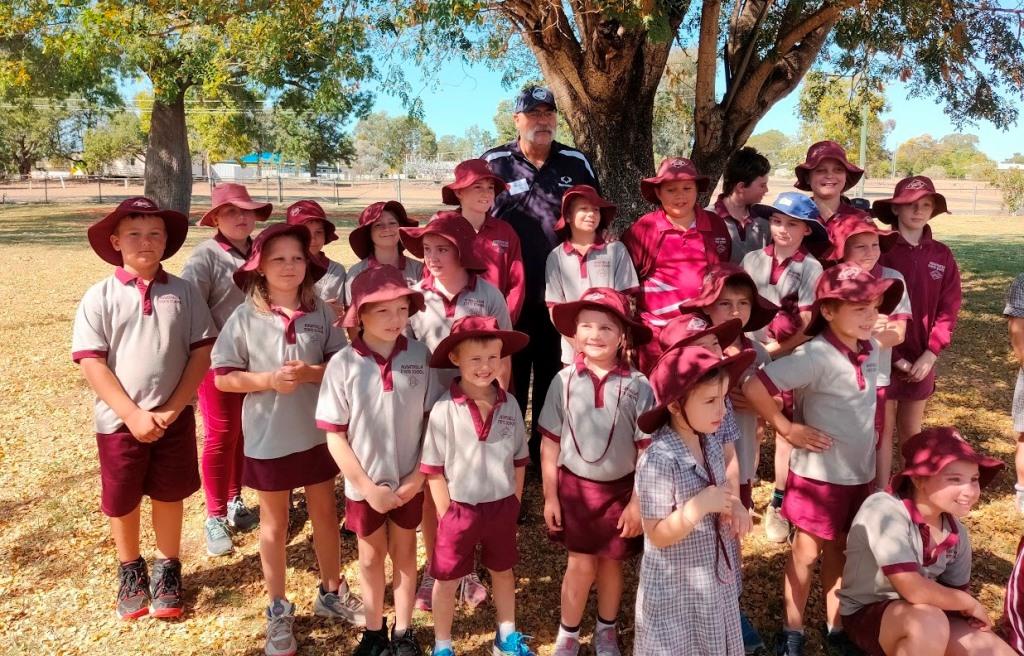 |
|
We then brought in the scooters and of course the kids got on them, started them, revved them, played with the controls, tooted the horn, all with smiles a mile wide.
Great to see!
|
 |
|
After the kids had scootered themselves out, we took them onto the school yard and gave them their “show bag” after which we were invited to an unbelievable morning tea, prepared by the school.
|
 |
|
Prior to starting off on our journey, John Broughton had bought a number of Rosemary seedlings, one for each school we intended to visit. After we’d enjoyed their magnificent morning tea, John presented one to the school, telling the kids the significance of wearing Rosemary on memorial days and asked them to plant and carefully care for the seedling.
|
|
After leaving the school, we set forth again in a northerly direction heading for Tambo where we intended to lunch at the Royal Carrangarra Hotel. This hotel sits on outback Qld’s oldest licenced hotel site. A William Coverly built and opened the first pub in Tambo in 1863. It was named after the settlement, "Carrangarra" which is an aboriginal word meaning a feasting and resting place. The hotel was also the site of the first postal service in Tambo with Cobb & Co. coming into Queensland in 1863, with the hotel being one of its first stopovers.
The hotel has burnt down three times. A Mr E. Parr came into possession of the hotel in 1922 and rebuilt the current building after it had burnt down in 1954 for the third time.
New owner Ben Casey took over the hotel in 2018 and hopes to provide a hotel that gives patrons a fun, safe and memorable experience of outback hospitality. It also serves up damn good pies, much to Jillian O’Toole’s delight.
The "Carra" is also home to Ben's Chicken Races, which has been described as "the best night on our trip, possibly ever!". 7 nights a week from April 1st until October 31st, at 5pm, Ben's ladies race around a track, entertain the masses and raise money for charity. Ben kindly put on a midday show for us, he auctions off his chickens, which are dyed a different colour so as to ID them, with all the auction money going into kitty. When all chickens are “sold”, they are placed in a ring, a small radio-controlled car containing a cup of feed is also placed in the ring and set off. The chickens of course chase the car keen to get to the feed. They do several laps and finally there is a winner, the chook which first crosses the finish line. The lucky person who had bought the winning chook gets half of the money in kitty with the other half going to charity. Ben kindly donated this half to Legacy.
Ros Curran had bought the winning chook, she pocketed $280.00
|
|
Pub owner Ben Casey with Ros and the winning chook.
You can see the race below. |
|
|
|
Apart from having the Carra hotel, Tambo also is the home of the famous Tambo Teddies. Back in 1992 wool prices had crashed and the district was in the grips of a drought. The community of Tambo was challenged to come up with a new industry to sustain the economy of the little town. A brain storming session during a workshop developed the idea that Tambo could assist the wool industry, encourage tourists and create employment by making unique teddy bears from wool pelts and stuff them with wool.
Popular opinion said it wouldn’t work, but after many laughs, three women; Mary Sutherland, Charm Ryrie and Helen Sargood, decided to bite the bullet. After many frustrating months of designing and planning, the first Tambo Teddies were ready for sale in February 1993.
The impact and enthusiasm of the public was overwhelming and the business grew to employ over fifteen part time workers. Tambo Teddies takes pride of place in homes all over the world and the famous teddy bears have made the little town of Tambo the ‘outback Teddy capital of Australia’.
After more than twenty years sewing bears and managing the business, Mary Sutherland, the only remaining director decided to it was time to retire. Wishing to only sell to a local, Mary was delighted when three more local ladies decided to purchase this iconic business
The new owners, two teachers and an arts and cultural officer, took up the reins of Tambo Teddies in 2014. Since then, Tambo Teddies has been renovated, won a national competition and state awards and provided gifts for Royalty, Premiers and Ministers.
|
|
Merv with 2 of the ladies who produce the award winning Teddies.
|
|
Our next stop, and overnighter, was to be Blackall – a further 100km up the track. Craig and Emma Scholes, who contributed so much at Blackall, offered to show us around their property, Northampton Downs, which is about 30km south of Blackall.
We called in and Craig gave us the Cook’s Tour, with a good look at the old Northampton shearing shed which is over 100 years old. Northampton Downs was part of the large Hampton Station which once covered a large area of land from south of Tambo to Blackall and was split in half by two brothers to create Southampton and Northampton and then into some smaller blocks over time. In its day a record was broken by 59 shearers, the men put 9,370 woolly ewes through in 8 hours and 15 minutes with hand sheers – an average of one every 3 and a bit minutes. Amazing!. When machines came, it changed to a 15 man stand shearing shed.
By the number of stands and down-tubes in the old shed, the Blackall area was once a huge sheep area but today most are all gone. Because of the large number of wild dogs in the area, farmers have diversified from sheep to cattle.
Today the shed sits unused.
|
|
We left Northampton Downs and continued on to Blackall where once again the local
Council had offered us the use of a pavilion in their showground. We intended to
spend 2 nights in Blackall as Emma and Craig had plans!
Being the sheep area it once was, it's not unusual that the Queensland Shearers
Union was formed in Blackall in 1887 following strikes at Wellshot Station and
surrounding properties the year prior. The union was formed to help combat
farmers’ attempts to lower the shearing rate. In the main street of Blackall,
you can find the Australian Federation Memorial, which commemorates where the
first meeting was held.
|
|
|
|
|
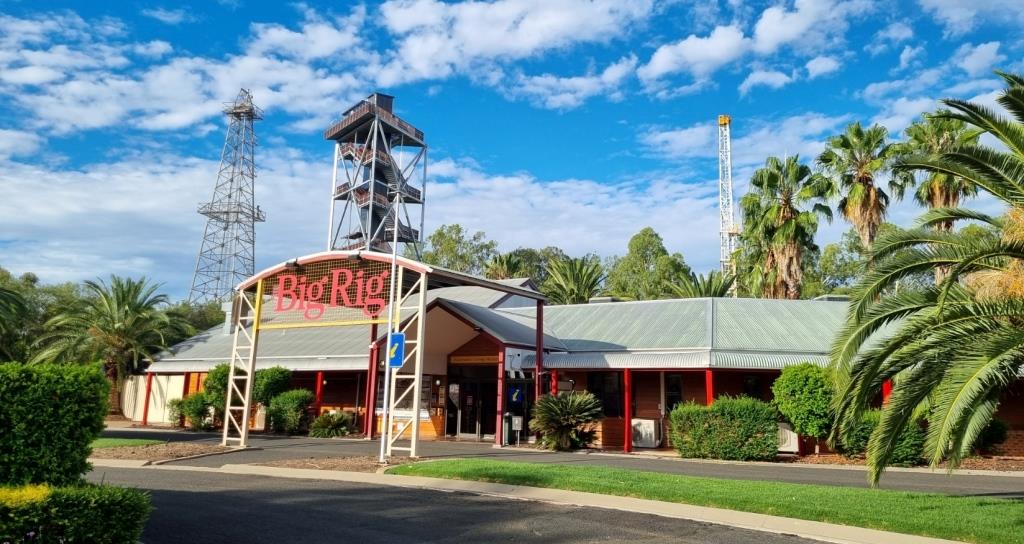
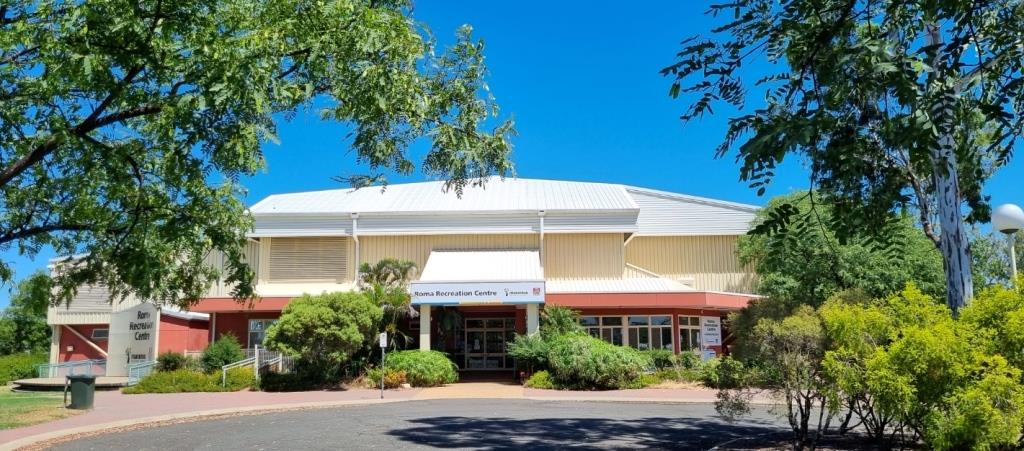

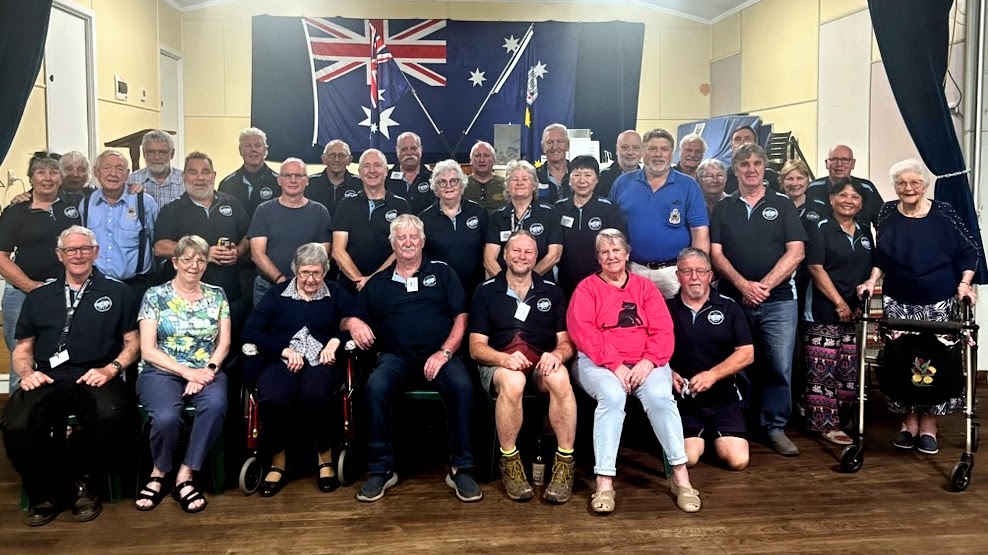
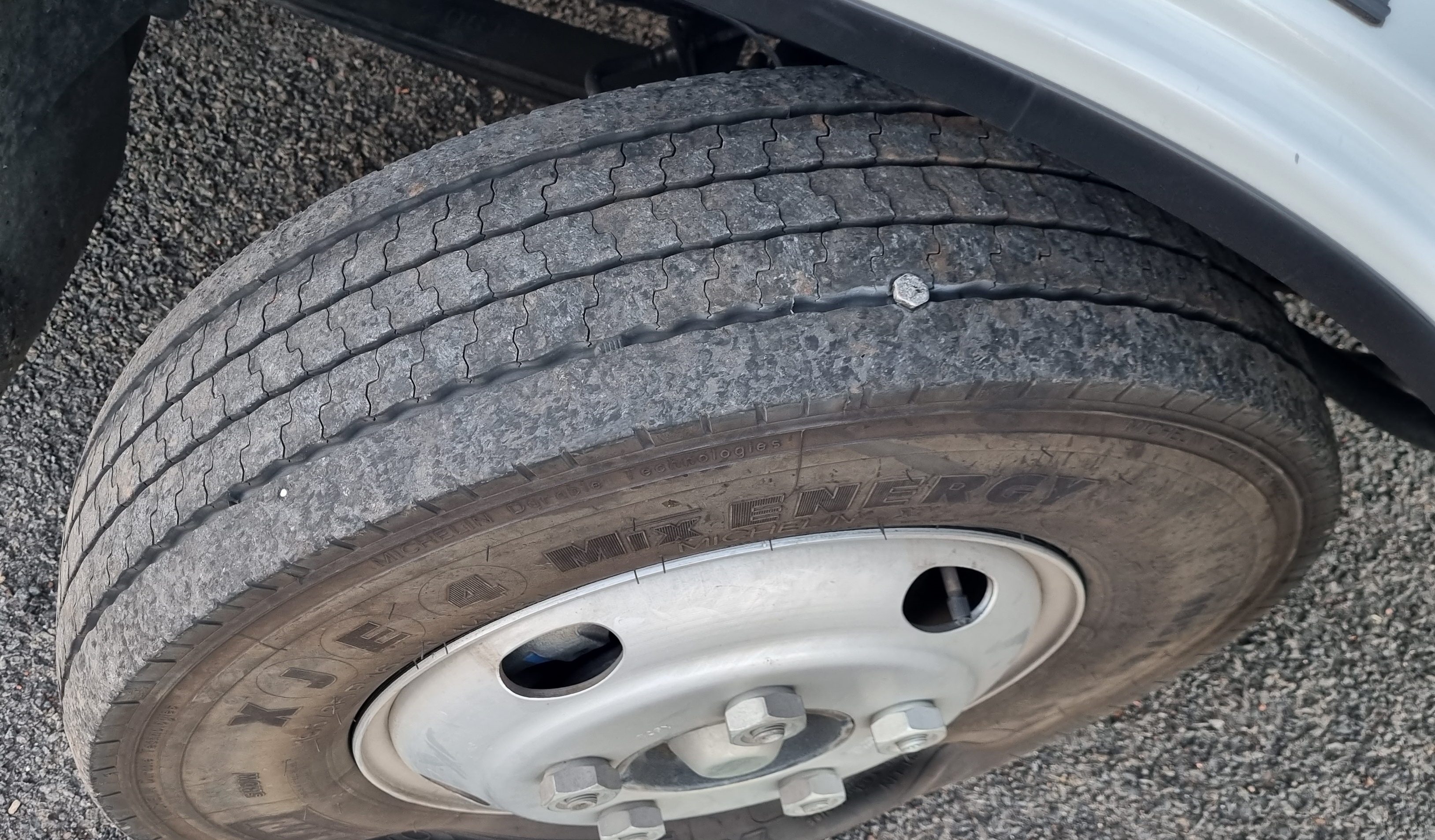



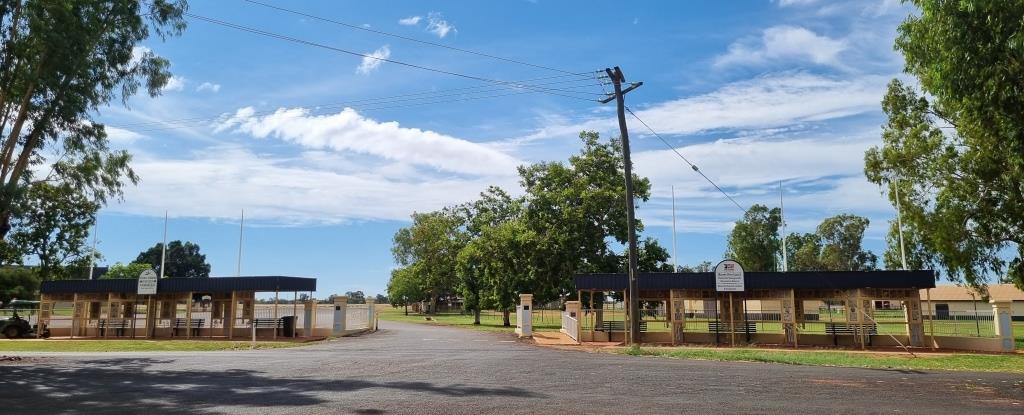
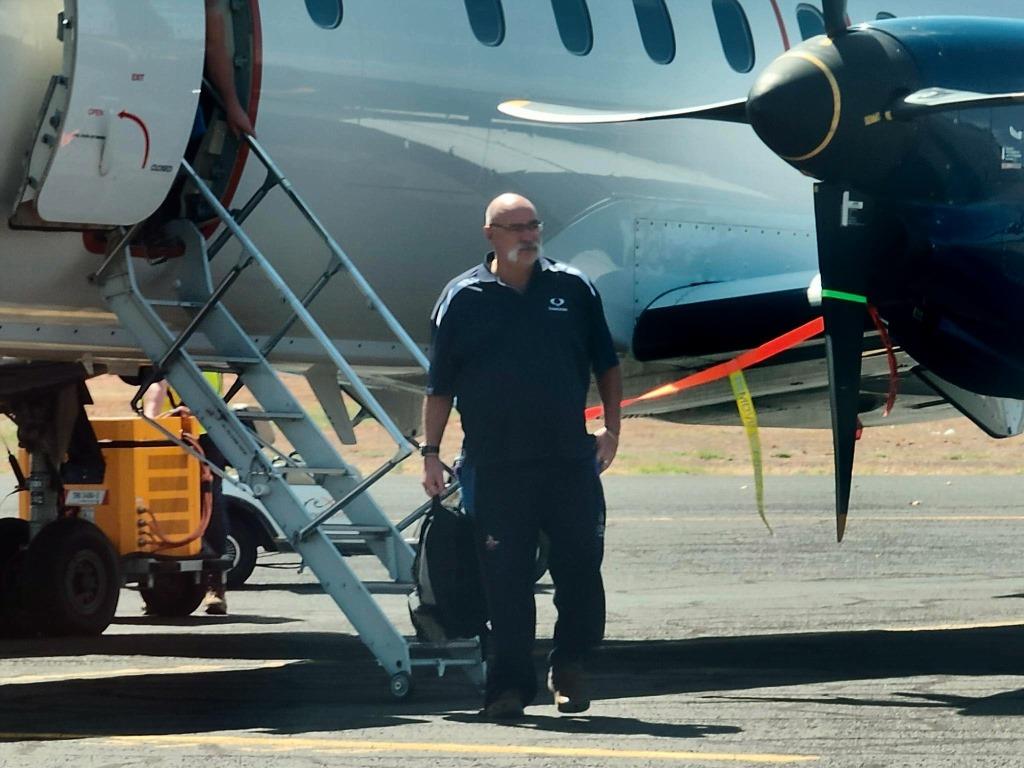
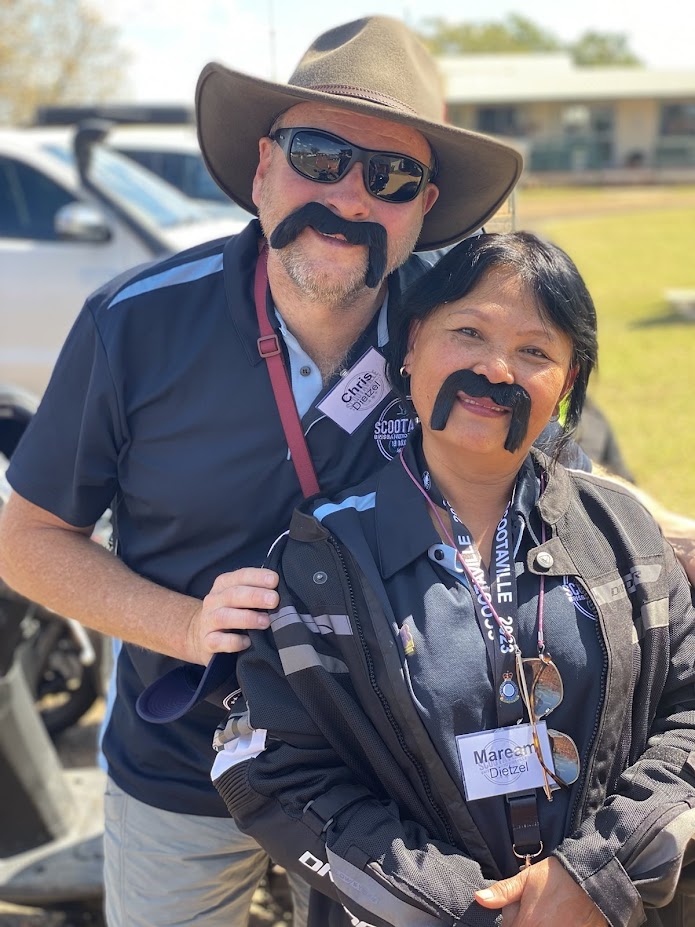
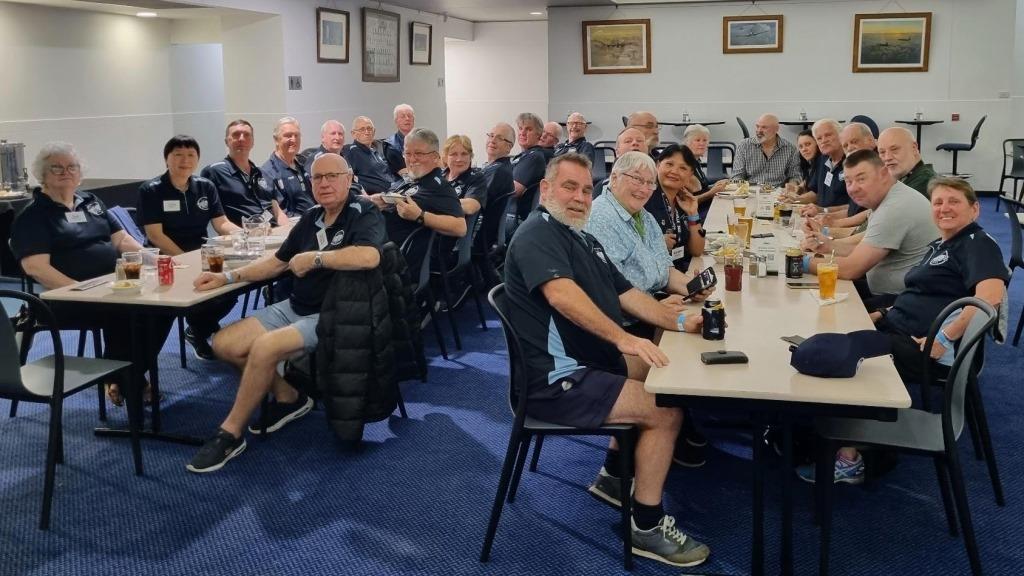
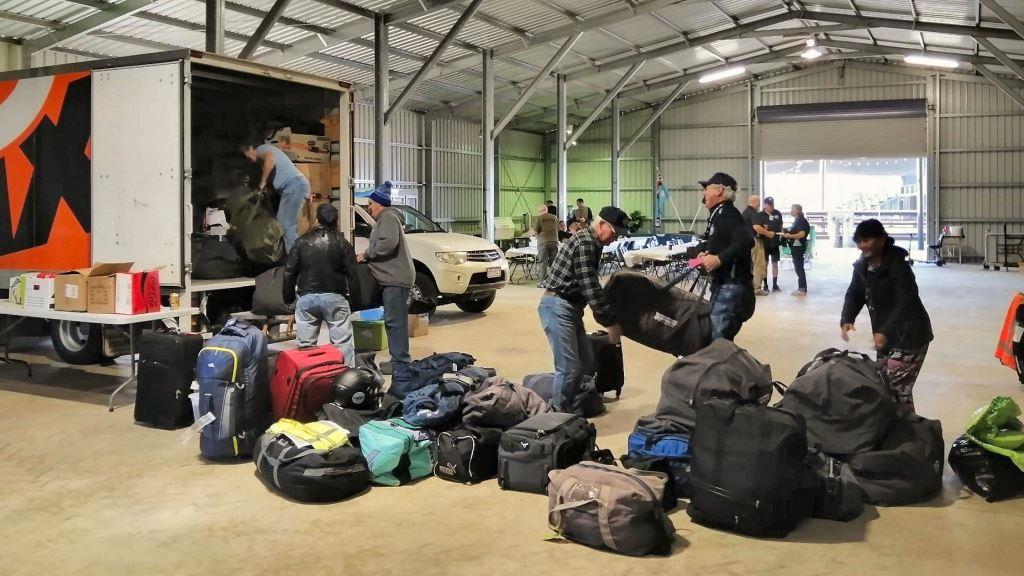
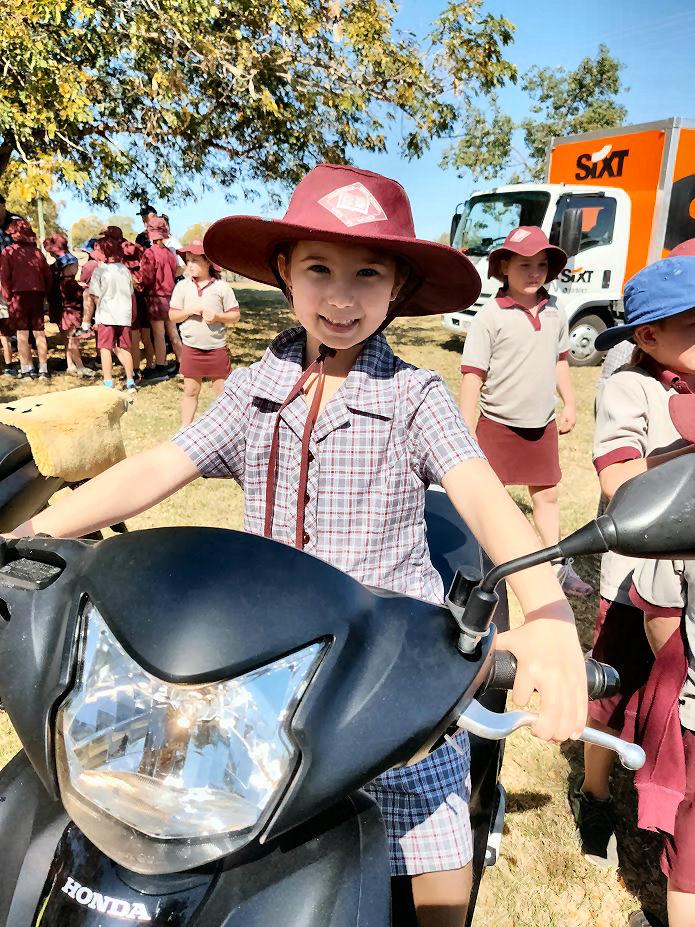
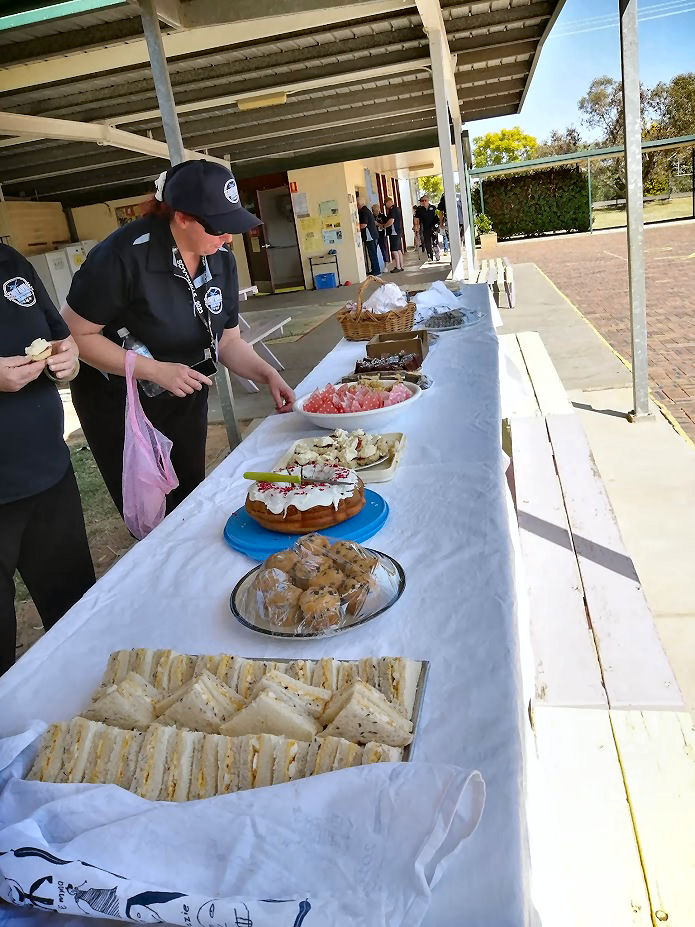
.jpg)
%20a.jpg)
%20a.jpg)
